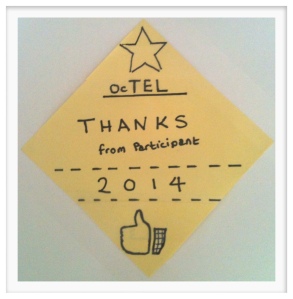For this task I contacted Gill Needham, Associate Director and Richard Nurse, Library Services Manager at the Open University, who worked on an innovative project called “TELSTAR”. Technology Enhanced Learning supporting Students to achieve Academic Rigour. TELSTAR aimed to answer the question “How can The Open University manage the process of integrating legacy systems into a recently introduced institution-wide VLE?”
1> What was the impetus and rationale behind the innovation?
The project was conceived back in 2008 as a way of improving approaches to referencing and addressing issues that had started to emerge with previous systems managing resource lists. The intention was to explore the area of reference management and build tools that could contribute to reducing plagiarism. The project ran until 2010
Aims and objectives
To create an exemplar project that seeks to:
• replace the legacy system, MyOpenLibrary (MOL) with a more robust integrated technical solution for managing library content within the VLE workflow;
• model more effective bibliographic resource management for the institution and the broader e-learning communities which can ensure efficient, timely and more flexible distribution of these resources;
• investigate the impact on changing practice for managing bibliographic referencing within e-learning;
• support the development and application of high quality bibliographic management skills for learning and employability.
http://www.jisc.ac.uk/whatwedo/programmes/institutionalinnovation/telstar.aspx
http://www.open.ac.uk/blogs/telstar/
2> What has the innovation achieved so far in terms of student learning?
Students were given a tool integrated into the Moodle Virtual Learning Environment that allowed them to manage their references and style their references for import into their assignments. The tool provided a simpler reference management tool interface than the standard RefWorks interface so offered an easier adoption route for students. References were stored in RefWorks and students were able to use the full interface if they wished. At its peak the MyReferences tool was used by 60 modules in a quarter and nearly 500 users. From the start of the project in 2009 we saw the number of RefWorks users jump from 8,000 to 18,000 users by 2012.
The MyReferences software developed by TELSTAR was adopted and implemented in modified form at Southampton Solent University
http://ssudl.solent.ac.uk/2040/1/January_2012_31-38.pdf
3> What has its impact been on the staff involved and the wider institution?
The initiative was a joint exercise between two units at the OU, Library Services and Learning and Teaching Solutions. It was a good example of cross-unit collaboration and formed a model for several other cross-unit projects involving Library Services. The project did increase the involvement of Library Services in discussions and activities around the University’s key learning systems. The tool was also piloted as a method of allowing Faculty staff to manage lists of resources (essentially reading lists) for new modules in development.
The project did surface some of the issues around referencing, such as the variations in referencing styles across the University, inconsistent approaches to expectations on students in terms of whether referencing styles were assessed and marked and has led to some re-evaluation of the approach. This groundwork has meant that Library Services have been able to engage in a dialogue about moving the University to a scenario where understanding the principles of referencing, such as the reasons why and consistency are more important that the exact application of a specific referencing style. In part this has been driven by this project improving our understanding of the complexity of trying to manage referencing styles to keep them up-to-date and consistent and whether subscribed reference management tools are a sustainable long-term approach.
The project has had some impact outside the institution. It organised two Innovations in Reference Management workshops , established the Jisc mailing list READING-LIST-SOLUTIONS https://www.jiscmail.ac.uk/cgi-bin/webadmin?A0=READING-LIST-SOLUTIONS that continues to be active to this day, and published a Reference Management implementation toolkit via the project blog http://www.open.ac.uk/blogs/telstar/
4> How do you know it has had this impact? What evaluation strategies and methods have been used?
Within the project a series of focus groups were undertaken to help to identify student requirements and to test concepts.
The project included a separate evaluation workpackage that was undertaken by external consultants.
From the evaluation report March 2010
This set out to address five questions:
• How effectively the functionality developed and piloted fulfils project aims
• How effectively it meets user requirements
• What changes to existing practices may be needed to adopt the TELSTAR functionality across the institution
• Whether the functionality is appropriate and sustainable in the long-term
• What change management requirements and risks are implicit in this approach
The approach taken was a series of interviews with staff and two focus groups with students and associate lecturers
Conclusions
“The solution is seen as practical and usable, and providing an answer at entry-level to the problems in managing and citing references that students face. While there will no doubt be issues raised in promoting sustained use over a period of time by large numbers of students, the initial outlook is very promising.”
“Encouraging adoption
Many respondents, including our student testers, felt that the MyReferences functionality was simple enough that a great deal of support in using it would not be necessary. Clearly there will always be students who need help in making their way through any new online tool. However the key for student adoption identified by many is to ensure that they are aware of MyReferences and that the importance of good reference management is clearly explained to them: awareness of the importance of the issue and the availability of the tool rather than technical support.
The OU Library Information Literacy Unit has an initial role to play in producing support materials. However, the key to take up may be the engagement of academic departments and course teams in the longer term to integrate the tool into course material production, but in the shorter term to provide contextualisation of the support materials to their disciplines and course offerings and to promote them to ALs and students with clear scenarios for use with demonstrable benefits. Other opportunities for promoting the tool should be seized, such as introductory course materials, introductory videos to the VLE, study skills sessions, and so on. The aim should be to make the tool part of the standard offering the OU makes to support students in their study.
Some of the comments made to us indicated that there are differing views in the OU as to whether TELSTAR is part of the anti-plagiarism strategy, since as course team responsibility, or the information literacy strategy led by the library. This seems to us a false and unhelpful differentiation of what are essentially two sides of the same issue, and there is a need for a more integrated message to be promulgated. Hopefully this will result from the emerging new information literacy strategy being developed.
Significance for the sector
From our work summarised above TELSTAR clearly emerges as a potentially significant development for the OU in promoting information literacy and safeguarding against plagiarism. Work being planned for the next phase to test out the transferability of the solution to other institutions using Moodle and RefWorks will establish the extent to which it can be adopted by such institutions.
However the discussion following presentation of the solution to an event involving a range of institutions and bibliographic management suppliers (Innovations in Reference Management, held in Milton Keynes on 14 January 2010) established that the need for a reference management solution at entry level is widely felt and is generally seen as a gap in the market. It is arguable that this is increasingly the case in the evolving web ecosystem within which students are able and should be expected to draw on a wider, greyer and potentially less stable range of sources and reference material than in days of print.
Other reference management software is designed to meet the needs of researchers and tends to be too complex to play this role. They do not engage students who do not see themselves as researchers but who need to be encouraged to take their first steps in reference management, and such students do not anyway need the more complex functionality when they currently have only limited collections of references to manage. The more conscientious students will adopt ad hoc solutions of their own devising, while others will just struggle to meet academic requirements or use labour-intensive methods.
While the TELSTAR solution is tailored to the specific circumstances of the OU and cannot, as a piece of software development, be implemented outside of a Moodle environment, the principles underpinning its development have much wider resonance and deserve to be generally promoted across the sector.“




You must be logged in to post a comment.